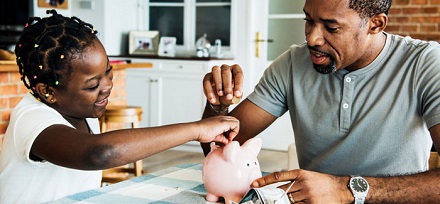Activities Beyond the Screen to Teach Your Kids to Be Financially Fit??

By Hugh Norton
Parents take their children’s financial future seriously, and technology provides an ever-evolving variety of fun and innovative ways to teach kids about money. However, some parents are concerned about limiting their kids’ screen time, and others may be looking for more hands-on activities to use to add to their children’s financial tool kit. Luckily, there are many off-screen ways to discuss, explore and learn about personal finance.
When un-plugged from devices, there are lessons and activities available to promote financial fitness, which can vary depending on your child’s age and temperament. Here are a few ideas to get you thinking about how you can to approach this important topic.
Have them compare everyday expenses. Regularly discuss how much everyday items, such as groceries, meals out and household supplies, cost. Then have your kids brainstorm ways to save money. Whether they’re comparison shopping or coupon hunting, they’ll learn what a normal week’s expenses might be and practice budgeting in the process.
You can also segue these activities into discussions about wants versus needs, such as the need to eat dinner versus the want to make a spontaneous trip to an expensive restaurant. Or the want for a game that they can’t afford unless they make money and save up first. These are good financial habits to instill and remind yourself of at any age.
Practice calculating savings. Looking for ways to save money can also double as a math lesson ??? good for staying sharp during the summer ??? and may lead to some surprising discoveries. For example, a sale where you buy one item and get a second of equal value for 50 percent off is equivalent to 25 percent off your purchase. Twenty-five percent off may not sound as enticing to them as 50.
The exercise could help teach them to consider how much they’re going to spend rather than how much they’ll “save.” You can use these sales-related examples to point out that if you weren’t planning on making the purchase anyway, buying something because it’s on sale isn’t really saving at all. I had a college friend that loved to quote his father saying, “never spend a dollar just to save a nickel.”
You can also combine financial education with math practice when you dine out by having your children calculate the tip. Reviewing the bill could help them appreciate the true cost of a meal, which may be much higher than the menu price due to tax and tip.
Make saving a regular and physical activity. Creating several savings jars is a common practice among parents who are teaching their kids about money, and it’s one worth considering as a precursor to opening an account. The idea is simple: have three jars (piggy banks or other containers) for spending, saving and charity.
Whenever kids get an allowance, money from work, a gift or any other sort of income, you ask them to split it up among the three jars. The split could be done evenly or divided in another way; that’s a decision that you can make together.
Having the physical jars can be helpful, especially with younger children, as they can see the money grow over time. Once they’re older, you can continue a similar practice by introducing them to checking and savings accounts.
Be honest and open the books. It’s up to you to decide how much detail you want to share, but offering examples of how you manage your finances could help your children prepare for the real world. Sharing food and household expenses with them could be a starting point, but you may also want to consider adding other, recurring bills into the mix.
For example, you could go over the monthly utility bill together and discuss how the family’s energy-related actions affect the bill and ways you could all help cut costs. Or go over a bank or credit card statement together and examine each transaction and how it played into the family budget or your individual budget.
You may also want to share examples of monthly loan payments to prompt a discussion of interest rates. Reviewing savings or investment account statements can be an opportunity to show how compound interest could help them grow their money.
Lead by example. Working on financial skills with practice, lessons and stories is important but many children also learn good and bad habits by the examples that their parents set. Consider this an opportunity to brush up on your own financial knowledge and then practice the skills you’d like to pass down.
Bottom line: Financially literacy isn’t something you can teach in a week or with a single method. You may be able to memorize some practical knowledge, such as how interest works, but it can take time for the more important practices to become regular habits. By utilizing a variety of methods to teach and show your kids how to handle money, you can help them prepare for a healthy financial future.
Hugh Norton directs Visa’s financial education programs. To follow Practical Money Skills on Twitter: www.twitter.com/PracticalMoney.
